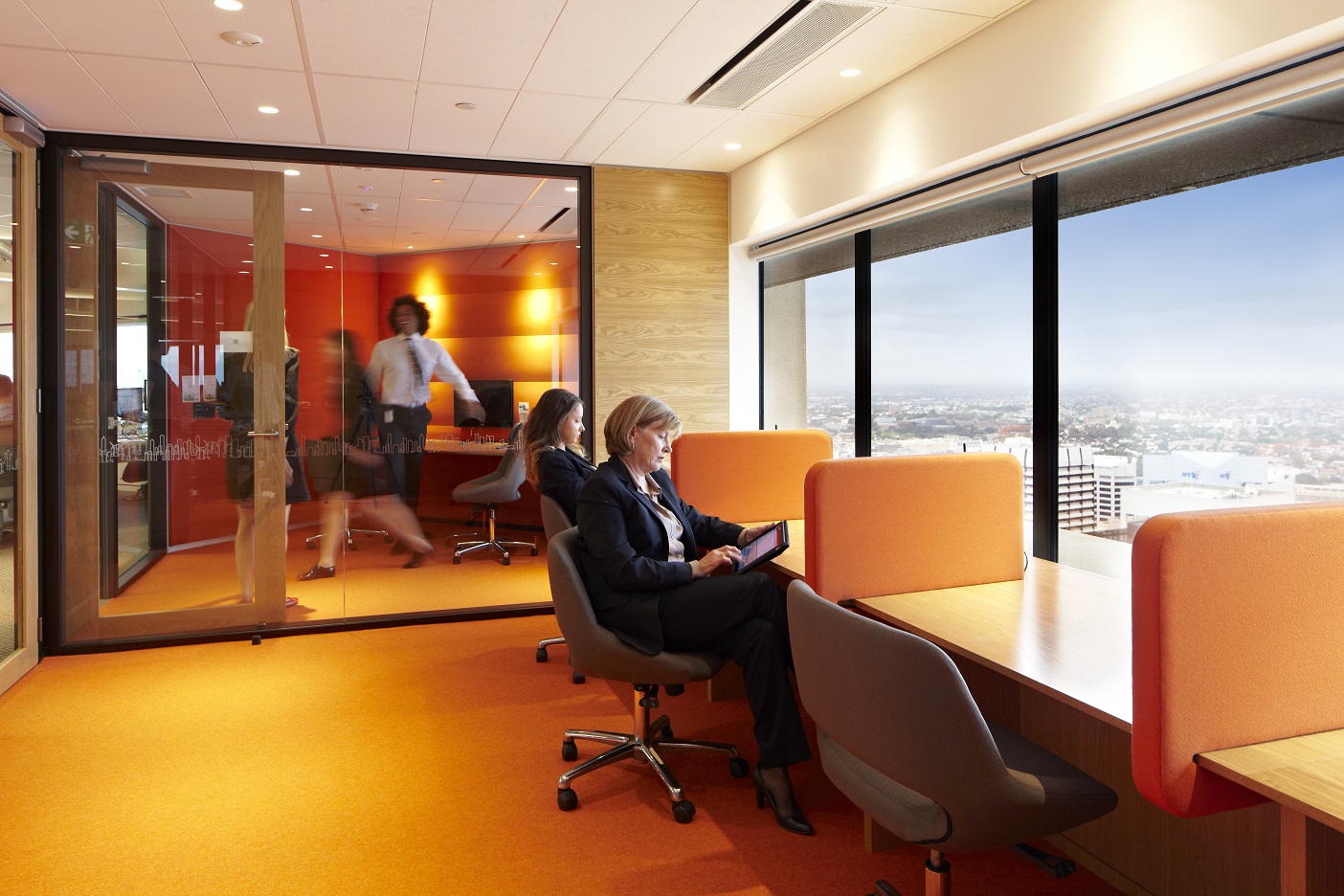'BYO Desk': How Melbourne's newest coworking space gives a glimpse of the future

MELBOURNE -- A steady hum of productivity scores the scene as employees sip their takeaway Australian-style flat white coffees, and jump onto their computers, scanning their weekend build-up of emails. While at a glance it looks like business as usual, a closer look reveals this is a work place that validates an unconventional way of working.
Space&Co., launched last month, is a physical space owned by property investors GPT who claim to be one of the first businesses in Australia to bring the teleworking-tenancy model to a wider, corporate market, selling memberships to employers and freelancers, leasing out offices, meeting rooms and project space on a month-to-month basis. Last year, GPT invested AUD $6 (USD$5.8) million investment into LiquidSpace, a web platform and app that allows users to easily book workspace and meeting rooms across the world. Despite current modest membership numbers (under a dozen), GPT is hedging its bets that its location in the financial district and unique setup of short lead-times and flexible contracts will attract large organizations rather than just startups and entrepreneurs.
The space is emblematic of the growing teleworking trend in Melbourne and around the world that marches to the mantra of "work is something you do, not somewhere you go." Of course, teleworking is nothing new. Organizations have been exploring alternative workplace strategies for years, predominantly driven by cost-saving incentives. But now, companies are actively pursuing alternative workplaces because they recognize the importance of employee attraction and retention. From corporate behemoths like Google and Salesforce to independent workers, many businesses are looking to swap the stodgy, inflexible corporate environments, typified by fixed contracts, for a more flexible arrangement.
Available statistics show around a quarter of working Australians work at least some hours at home. And according to Sensis, an Australian advertising network, teleworking in Victoria increased from 24 percent in 2007 to 27 percent in 2009. Even the Australian government is responding to the changing needs of the workforce; they recently set a goal to have 12 percent of public servants teleworking one day a week by 2020.
Caroline McLaren, an advocate for flexible workplaces, explains while Space&Co. along with its competitors Regus and Servcorp, may operate similarly to other coworking spaces in terms of sign-up (done via a simple web form), it has a competitive advantage in its varied membership options and its advanced workplace technologies for a wireless and paperless office. Also, GPT is targeting larger organizations who, for example, might need a temporary space due to staff overflow during peak periods or conduct one-off strategy days.
McLaren whose consultancy, Coactiv8, was hired by GPT to set up Space&Co, says the emergence of Space&Co. and its Sydney location, Rouse Hill, is a sign that flexible workplaces will become more mainstream. "To date coworking spaces have tended to be in alternative buildings, and not in the heart of the city. I don’t know of any coworking space internationally that is based in a large corporate tower," McLaren says.
"These new flexible work spaces in mainstream locations places power in the hands of the consumer to choose when and how they work," she says. "It's a just like the corporate shift to the iPhone; Blackberry had been the preferred corporate mobile phone solution for security reasons, however employee [i.e. the consumer] demand for iPhones forced companies to change their policies. Now more business people use iPhone devices than all of Blackberry’s mobile devices combined."
The Melbourne consultant explains that for a long time, workplaces have been the decision of corporate procurement teams, based on long-term, organizational-wide considerations, but today, companies have less of an influence over the systems and tools their employees choose.
And while teleworking is influencing future work trends in Melbourne, it’s also set to change commercial real estate, a market typified by a cumbersome business-to-business sales process that requires long lead time, complex contracts and limited customer interaction in a market over-supplied with office space.
According to a Knight Frank property report, Melbourne's office rental prices have fallen by 4 percent during 2013 but plateaued in the second half of 2013. The current economic conditions makes it “a renters' market” with landlords competing to secure good tenants.
"Tenants remain in a strong position to negotiate the terms of the lease, including the term, rental and incentive levels," James Templeton, managing director for Knight Frank Victoria, says. "With leasing activity patchy and occupiers reluctant to relocate, rental levels have only recorded modest growth over the last three years."
He also warns that in 12 months' time, the market will swing back in favor of landlords, but explains that flexibility to tenant requirements will still be required, given the depth of Melbourne’s office markets.
"Tenants will always have various options available," he says. "Landlords will need to have strategies in place to accommodate existing tenants who undergo rapid growth and need additional real estate space to keep them in their buildings, otherwise landlords will see those tenants opting for alternative accommodation solutions."
Templeton predicts rental costs will increasingly become variable rather than fixed. And as such, believes the commercial real estate industry will realize the market opportunity in bridging the gap between offering standard office space with long leases and consumer-oriented workplace arrangements. In ten years' time, he expects there will be even more innovative options for commercial tenants.

McLaren agrees with Templeton, and says serviced offices which have traditionally served a very functional solution are increasingly focused on connectivity and communications, which are at the core of teleworking.
Connectivity in this instance relates to both the online and offline world; the spaces themselves are designed to help people connect -- including the physical office design, staffing and event programming, with a number of platforms such as member walls or online communications platforms to help members of the space meet each other.
"There is a good chance that companies will offer BYO desk arrangements, where employers would pay for a flexible workplace membership that would allow employees to work in a variety of spaces, in the same way they offer BYO device arrangements," McLaren predicts. "And of course, with the emergence of cloud computing, telecommuting is likely to continue to grow which will only further strengthen employee mobility."
From whatever vantage of the labor market, all roads point to an increasing appetite for a dramatic rethink of the environments workers choose to inhabit. "With the battle for top quality talent still fierce, today’s workplace can no longer be defined by a ‘one size fits all’ solution," Templeton says. "Businesses need to create a work environment where all employees work successfully together."
Image: Nathan Dyer (main), GPT
Sign up for our biweekly newsletter featuring in-depth business innovation stories by correspondents around the globe, top domestic reporters and thought-provoking opinion columnists
This post was originally published on Smartplanet.com